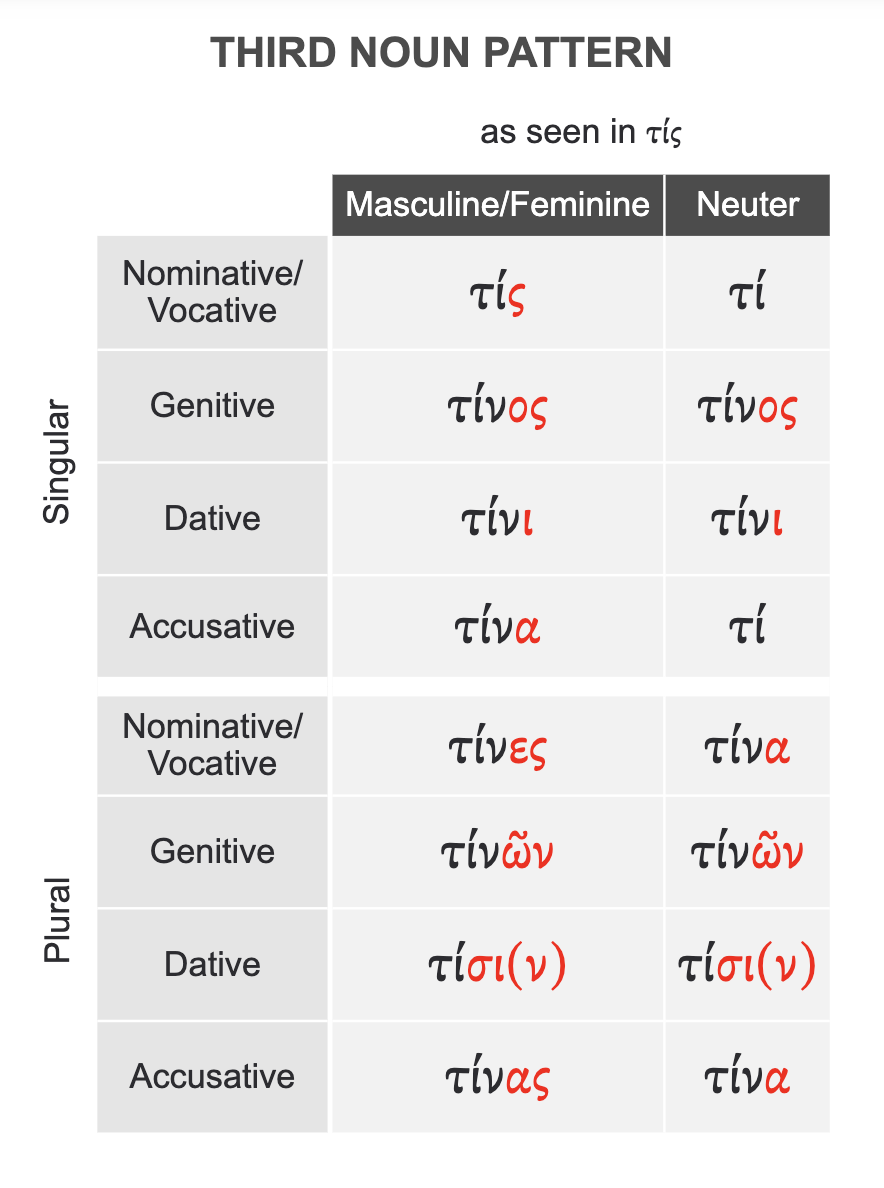Lesson 5 | The Third Noun Pattern
Grammar Point 1: The Third Noun Pattern
The Third Noun Pattern
The Third Noun Pattern is the most difficult noun pattern to learn. Not only do we have to deal with scheming σ and timid τ, but there are also a lot of differences between the kinds of stems that we find in third pattern nouns. πατήρ is a very different stem from αἰών. πίστις is a very different stem from σάρξ. Therefore, our goal for this step is not to teach you how to write out every third pattern noun. Instead, our goal for this step is to give you the basic tools you need to parse and translate third pattern nouns.
The first tool that you need is a paradigm to help you remember the basic forms of third pattern nouns. We will use the word τίς for this. τίς is the question pronoun, and it follows the Third Noun Pattern. If you memorize this pattern, you should be able to recognize and parse other third pattern nouns.

There are a few things to point out about this paradigm. The stem of τίς is τιν. In the masculine/feminine nominative singular, the ς ending forces the ν to drop out: τιν + ς = τίς. This also happens in the masculine/feminine dative plural: τιν + σιν = τίσιν. Here is the important point. The σ-endings in the nominative singular and dative plural forms usually change or alter the third pattern noun’s stem in some way. The following chart displays the changes you can expect.

In the neuter nominative and accusative singular, we get τί because the ν acts like timid τ and drops off the end of the word. This is an important rule for third pattern neuter nouns. Many of these nouns have stems that end in -ματ, like πνεύμα, ῥῆμα, αἷμα, and στόμα. In the nominative and accusative neuter singular, the timid τ drops off from the end of the word.
Further, notice that some of the rules we learned for second pattern nouns still apply. For example, the neuter nominative and accusative forms are identical. Also, the neuter genitive and dative forms are the same as the masculine ones.
Other than this paradigm and these rules, you need to know the genitive form for each third pattern noun that you learn. Learning the genitive form will teach you the word’s stem, which is usually messed up by scheming σ or timid τ in the nominative singular form.
Finally, do not forget the article! The article always follows the First and Second Noun Patterns, even when it modifies a third pattern noun. If you are having trouble with a third pattern noun, check if it has an article with it to help you.
In summary, remember these tools for the Third Noun Pattern:
- The paradigm
- The rules
- Scheming σ often alters the stem in the nominative singular and dative plural.
- Timid τ often changes the stem of neuter nominative and accusative singular forms.
- The Second Noun Pattern rules for neuter nouns still apply.
- Neuter nominative and accusative forms are identical.
- The neuter genitive and dative forms are the same as the masculine forms.
- The genitive singular form Memorizing this will provide you with a third pattern noun’s unaltered stem (eg. πνεῦμα, πνεῦματος, τό).
- The article Look for the article to help you parse difficult third pattern nouns.
Use this quizlet to help you see how well you can parse third pattern nouns with these tools.
Once again, you do not need to memorize all the different forms—memorizing the paradigm for τίς will suffice. Your goal should be to learn the tools well enough that you can parse third pattern nouns in the Greek NT.
And now we can put all three noun patterns and the article in a single paradigm.
